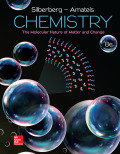
(a)
Interpretation:
An overall equation for the given reaction has to be written.
Concept introduction:
Reaction: Substances which are mutually involved each other in a chemical process and changed into different substances.
Mechanism of a reaction: The representation of step by step process involved in the chemical process is said to be mechanism of a
Elementary step: The first step in a reaction mechanism is said to be elementary step.
Intermediate: Sometimes, in between the reaction some separable amount and useful amount of substances are formed during the reaction and which are said to be intermediates
(a)
Explanation of Solution
The given reaction involves multiple mechanism steps, by adding the entire individual steps gives rise to an overall reaction equation. Hence, the reaction equation as follows,
In the reaction, the slow step is the rate determining step; and its rate law is the overall rate law. The overall equation becomes,
(b)
Interpretation:
The intermediate has to be identified.
Concept introduction:
Rate law or rate equation: The relationship between the reactant concentrations and
Order of a reaction: The order of a reaction with respect to a particular reactant is the exponent of its concentration term in the rate law expression, and the overall reaction order is the sum of the exponents on all concentration terms.
Rate constant, k: It is a proportionality constant that relates rate and concentration at a given temperature.
(b)
Explanation of Solution
The given reaction involves multiple mechanism steps, by adding the entire individual steps gives rise to an overall reaction equation. Hence, the reaction equation as follows,
The intermediates are not involved in the overall reaction; thus, the components ‘X and Y’ are intermediates and produced and consumed in the reaction.
(c)
Interpretation:
The molecularity and the rate law for each step has to be identified.
Concept introduction:
Rate law or rate equation: The relationship between the reactant concentrations and reaction rate is expressed by an equation.
Order of a reaction: The order of a reaction with respect to a particular reactant is the exponent of its concentration term in the rate law expression, and the overall reaction order is the sum of the exponents on all concentration terms.
Rate constant, k: It is a proportionality constant that relates rate and concentration at a given temperature.
(c)
Explanation of Solution
Step 1:
Molecularity (collision) of a reaction step (1) is the number of reactant involved in that elementary step. Here, two molecules A and B are involved; thus, molecularity is BIMOLECULAR. The rate law of this step is
Step 2:
Molecularity (collision) of a reaction step is the number of reactant involved in that elementary step. Here, two molecules X and C are involved; thus, molecularity is BIMOLECULAR. The rate law of this step is
Step 3:
Molecularity (collision) of a reaction step is the number of reactant involved in that elementary step. Here, only one molecule Y is involved; thus, molecularity is UNIMOLECULAR. The rate law of this step is
(d)
Interpretation:
The mechanism whether consistent with the given rate law has to be predicted.
Concept introduction:
Rate law or rate equation: The relationship between the reactant concentrations and reaction rate is expressed by an equation.
Order of a reaction: The order of a reaction with respect to a particular reactant is the exponent of its concentration term in the rate law expression, and the overall reaction order is the sum of the exponents on all concentration terms.
Rate constant, k: It is a proportionality constant that relates rate and concentration at a given temperature.
(d)
Explanation of Solution
In the reaction, the slow step is the rate determining step; and its rate law is the overall rate law. The overall equation becomes,
The overall reaction rate is same as the rate of slowest reaction step.
The slowest step is,
The rate law for the above reaction is,
The concentration
The rate law for the given mechanism steps are,
The rate of mechanism (1),
Thus, by substituting above relation into the equation (1), the rate law becomes,
Therefore, the given rate law is consistent with the rate law of overall reaction
(e)
Interpretation:
The given one-step mechanism whether is equally valid has to be predicted.
Concept introduction:
Rate law or rate equation: The relationship between the reactant concentrations and reaction rate is expressed by an equation.
Order of a reaction: The order of a reaction with respect to a particular reactant is the exponent of its concentration term in the rate law expression, and the overall reaction order is the sum of the exponents on all concentration terms.
Rate constant, k: It is a proportionality constant that relates rate and concentration at a given temperature.
(e)
Explanation of Solution
The given one-step mechanism is,
The rate law for the above reaction is,
Yes, the rate law of one-step reaction mechanism is equal to the actual rate law.
Want to see more full solutions like this?
Chapter 16 Solutions
EBK CHEMISTRY: THE MOLECULAR NATURE OF
 ChemistryChemistryISBN:9781305957404Author:Steven S. Zumdahl, Susan A. Zumdahl, Donald J. DeCostePublisher:Cengage Learning
ChemistryChemistryISBN:9781305957404Author:Steven S. Zumdahl, Susan A. Zumdahl, Donald J. DeCostePublisher:Cengage Learning ChemistryChemistryISBN:9781259911156Author:Raymond Chang Dr., Jason Overby ProfessorPublisher:McGraw-Hill Education
ChemistryChemistryISBN:9781259911156Author:Raymond Chang Dr., Jason Overby ProfessorPublisher:McGraw-Hill Education Principles of Instrumental AnalysisChemistryISBN:9781305577213Author:Douglas A. Skoog, F. James Holler, Stanley R. CrouchPublisher:Cengage Learning
Principles of Instrumental AnalysisChemistryISBN:9781305577213Author:Douglas A. Skoog, F. James Holler, Stanley R. CrouchPublisher:Cengage Learning Organic ChemistryChemistryISBN:9780078021558Author:Janice Gorzynski Smith Dr.Publisher:McGraw-Hill Education
Organic ChemistryChemistryISBN:9780078021558Author:Janice Gorzynski Smith Dr.Publisher:McGraw-Hill Education Chemistry: Principles and ReactionsChemistryISBN:9781305079373Author:William L. Masterton, Cecile N. HurleyPublisher:Cengage Learning
Chemistry: Principles and ReactionsChemistryISBN:9781305079373Author:William L. Masterton, Cecile N. HurleyPublisher:Cengage Learning Elementary Principles of Chemical Processes, Bind...ChemistryISBN:9781118431221Author:Richard M. Felder, Ronald W. Rousseau, Lisa G. BullardPublisher:WILEY
Elementary Principles of Chemical Processes, Bind...ChemistryISBN:9781118431221Author:Richard M. Felder, Ronald W. Rousseau, Lisa G. BullardPublisher:WILEY





